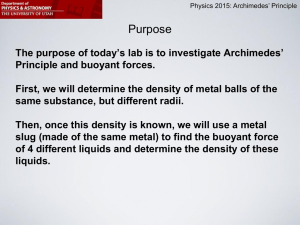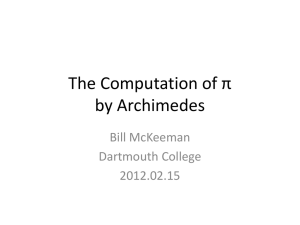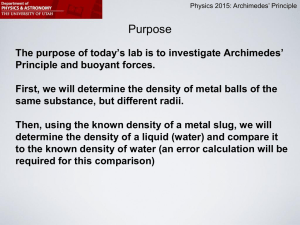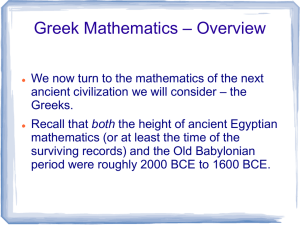Presentation on Archimedes
advertisement
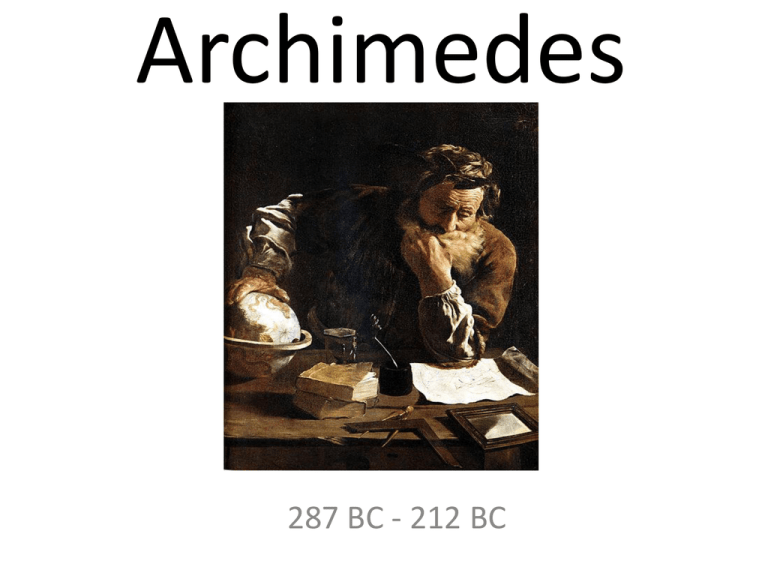
Archimedes 287 BC - 212 BC • Archimedes of Syracuse was a Greek mathematician, physicist, engineer, inventor, and astronomer. Although few details of his life are known, he is regarded as one of the leading scientists in classical antiquity. Among his advances in physics are the foundations of hydrostatics, statics and an explanation of the principle of the lever. He is credited with designing innovative machines, including siege engines and the screw pump that bears his name. Modern experiments have tested claims that Archimedes designed machines capable of lifting attacking ships out of the water and setting ships on fire using an array of mirrors. • Archimedes is generally considered to be the greatest mathematician of antiquity and one of the greatest of all time. He used the method of exhaustion to calculate the area under the arc of a parabola with the summation of an infinite series, and gave a remarkably accurate approximation of pi. He also defined the spiral bearing his name, formulae for the volumes of surfaces of revolution and an ingenious system for expressing very large numbers. About Archimedes • Archimedes was born c. 287 BC in the seaport city of Syracuse, Sicily, at that time a self-governing colony in Magna Graecia. The date of birth is based on a statement by the Byzantine Greek historian John Tzetzes that Archimedes lived for 75 years. In The Sand Reckoner, Archimedes gives his father's name as Phidias, an astronomer about whom nothing is known. Plutarch wrote in his Parallel Lives that Archimedes was related to King Hiero II, the ruler of Syracuse. A biography of Archimedes was written by his friend Heracleides but this work has been lost, leaving the details of his life obscure. It is unknown, for instance, whether he ever married or had children. During his youth, Archimedes may have studied in Alexandria, Egypt, where Conon of Samos and Eratosthenes of Cyrene were contemporaries. He referred to Conon of Samos as his friend, while two of his works (The Method of Mechanical Theorems and the Cattle Problem) have introductions addressed to Eratosthenes. A few of his Accomplishments • The most widely known anecdote about Archimedes tells of how he invented a method for determining the volume of an object with an irregular shape. According to Vitruvius, a votive crown for a temple had been made for King Hiero II, who had supplied the pure gold to be used, and Archimedes was asked to determine whether some silver had been substituted by the dishonest goldsmith. Archimedes had to solve the problem without damaging the crown, so he could not melt it down into a regularly shaped body in order to calculate its density. While taking a bath, he noticed that the level of the water in the tub rose as he got in, and realized that this effect could be used to determine the volume of the crown. For practical purposes water is incompressible, so the submerged crown would displace an amount of water equal to its own volume. By dividing the mass of the crown by the volume of water displaced, the density of the crown could be obtained. This density would be lower than that of gold if cheaper and less dense metals had been added. Archimedes then took to the streets naked, so excited by his discovery that he had forgotten to dress, crying "Eureka!" (Greek: "εὕρηκα!," meaning "I have found it!"). The test was conducted successfully, proving that silver had indeed been mixed in. Finding Archimedes Works • The foremost document containing the work of Archimedes is the Archimedes Palimpsest. In 1906, the Danish professor Johan Ludvig Heiberg visited Constantinople and examined a 174-page goatskin parchment of prayers written in the 13th century AD. He discovered that it was a palimpsest, a document with text that had been written over an erased older work. Palimpsests were created by scraping the ink from existing works and reusing them, which was a common practice in the Middle Ages as vellum was expensive. The older works in the palimpsest were identified by scholars as 10th century AD copies of previously unknown treatises by Archimedes. The palimpsest holds seven treatises, including the only surviving copy of On Floating Bodies in the original Greek. It is the only known source of The Method of Mechanical Theorems, referred to by Suidas and thought to have been lost forever. Stomachion was also discovered in the palimpsest, with a more complete analysis of the puzzle than had been found in previous texts. The palimpsest is now stored at the Walters Art Museum in Baltimore, Maryland, where it has been subjected to a range of modern tests including the use of ultraviolet and x-ray light to read the overwritten text. The death of Archimedes • Archimedes died c. 212 BC during the Second Punic War, when Roman forces under General Marcus Claudius Marcellus captured the city of Syracuse after a two-year-long siege. According to the popular account given by Plutarch, Archimedes was contemplating a mathematical diagram when the city was captured. A Roman soldier commanded him to come and meet General Marcellus but he declined, saying that he had to finish working on the problem. The soldier was enraged by this, and killed Archimedes with his sword. Plutarch also gives a lesser-known account of the death of Archimedes which suggests that he may have been killed while attempting to surrender to a Roman soldier. According to this story, Archimedes was carrying mathematical instruments, and was killed because the soldier thought that they were valuable items. General Marcellus was reportedly angered by the death of Archimedes, as he considered him a valuable scientific asset and had ordered that he not be harmed. Archimedes last words • The last words attributed to Archimedes are "Do not disturb my circles" (Greek: μὴ μου τοὺς κύκλους τάραττε), a reference to the circles in the mathematical drawing that he was supposedly studying when disturbed by the Roman soldier. This quote is often given in Latin as "Noli turbare circulos meos," but there is no reliable evidence that Archimedes uttered these words and they do not appear in the account given by Plutarch. Archimedes Burial Site • The tomb of Archimedes carried a sculpture illustrating his favorite mathematical proof, consisting of a sphere and a cylinder of the same height and diameter. Archimedes had proven that the volume and surface area of the sphere are two thirds that of the cylinder including its bases. In 75 BC, 137 years after his death, the Roman orator Cicero was serving as quaestor in Sicily. He had heard stories about the tomb of Archimedes, but none of the locals was able to give him the location. Eventually he found the tomb near the Agrigentine gate in Syracuse, in a neglected condition and overgrown with bushes. Cicero had the tomb cleaned up, and was able to see the carving and read some of the verses that had been added as an inscription. A tomb discovered in a hotel courtyard in Syracuse in the early 1960s was claimed to be that of Archimedes, but its location today is unknown. References http://www.gingerelli.com/Sicily/Archimede s%20Tomb.jpg http://www.loc.gov/exhibits/vatican/images /math05.jpg http://en.wikipedia.org/wiki/Archimedes http://en.wikipedia.org/wiki/File:Domeni\co -Fetti_Archimedes_1620.jpg


